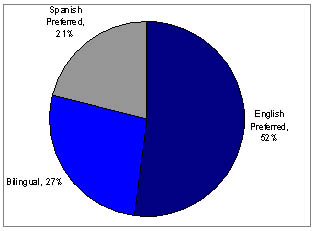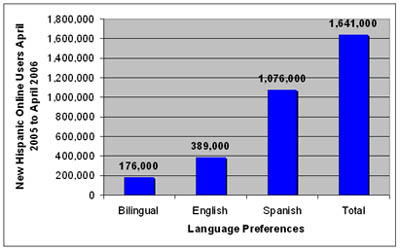
During the past decade and a half, the Hispanic market in the United States has grown dramatically. Hispanics are the nation’s fastest-growing ethnic market and largest minority group. According to the 2004 U.S. census, Hispanics represent 14% of the population and total 41.3 million individuals.
As the number of U.S. Hispanics grows, so does their adoption of technology. As AOL/Roper research indicates, U.S. Hispanics are embracing the Internet in increasing numbers, turning to it as a source of information, as a means to connect with their cultural heritage, as a way to communicate with family and friends, and as a channel for commerce. More than the general online population, U.S. Hispanics view the Internet as a tool for building better lives for their families.
Some interesting facts about the Hispanic online market:
- There were 15.9 million U.S. Hispanics online as of April 2006.
- Between April 2005 and April 2006, more than 1.6 million Hispanics came online for the first time, a year-over-year growth of more than 12%, making the U.S. Hispanic market the fastest-growing segment of the online population.
- Online Hispanics are an “upscale mass market”; 56% are college educated, and online Hispanics have a median income of $40,000.
-
In April 2006, comScore Media Metrix reported that 21% of all online Hispanics were Spanish dominant, 27% were bilingual, and 52% were English dominant. (See Figure 1.) But language preferences of online Hispanics are rapidly changing. As the English-dominant segment of the Hispanic online market reaches saturation, the newest arrivals to the Internet are Spanish-dominant Hispanics, who tend to be less acculturated.

Figure 1: Language Preferences of Online Hispanics,
April 2006 (Source: ComScore Media Metrix)According to ComScore Media Metrix, of the 1.6 million new Hispanic internet users who came online between April 2005 and April 2006, more than 65% were Spanish dominant. (See Figure 2.) This presents a unique challenge for marketers: In what language do you reach Hispanic online consumers?
To reach the aggregate Hispanic online market, you should use both English and Spanish. Online Hispanics, regardless of their language preference, want access to information in both English and Spanish. While Spanish language is clearly a necessity for Spanish-dominant Hispanics, it also plays a significant role for bilingual Hispanics online. AOL/Roper reports that the majority of bilingual Hispanics state that they wish they had access to information that was available in Spanish and wish more Websites were available in Spanish.

Figure 2: Hispanic Online Growth by Language Segment
April 2005-April 2006 (Source: ComScore Media Metrix)While growth rates in the Hispanic online market are impressive and the opportunity compelling, effectively targeting the Hispanic online market requires a deep understanding of its complexities. Among the most important factors marketers need to address to be successful are the unique language preferences and cultural predispositions of the Hispanic online market.
During the next six months, we will be publishing a series of articles on CHIEF MARKETER covering the top 10 Hispanic online best practices that companies can use to be successful in marketing to Hispanics online. Every two weeks we will present one best practice and illustrate it via case studies. For a preview of the top 10 Hispanic best practices, please go to http://capturagroup.com/connecting-with-hispanic-online-market.html.
Lee Vann is the cofounder of Captura Group, a leading Hispanic interactive services firm. He was recently recognized by the Interactive Advertising Bureau as one of the top 10 Hispanic online pioneers.
 Network
Network

